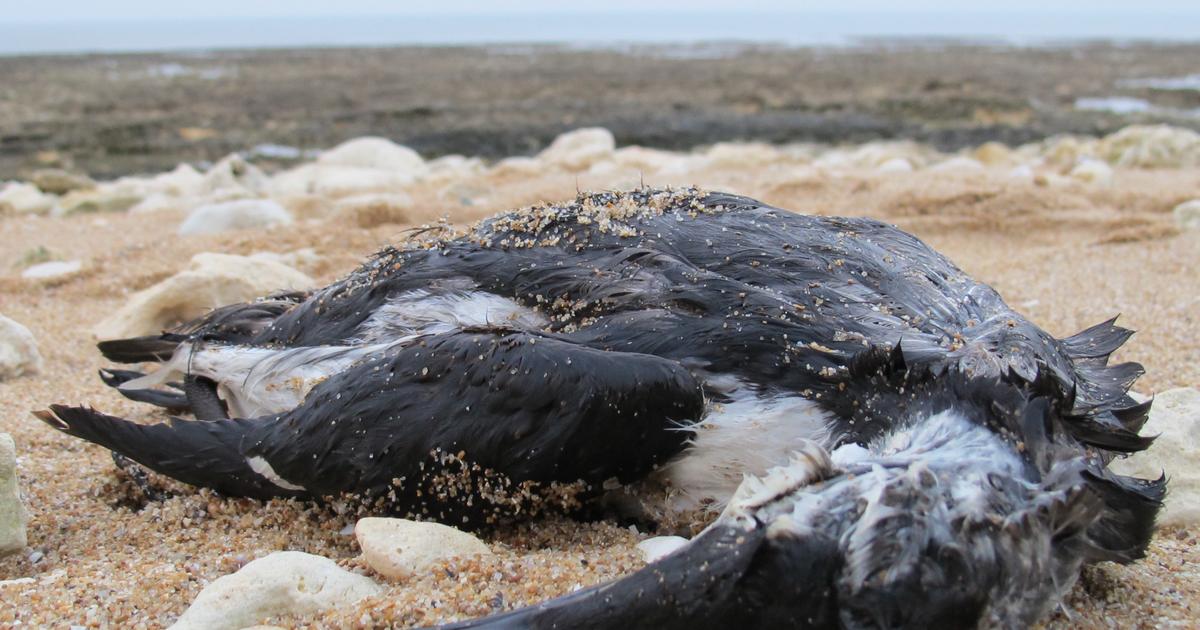For several days, volunteers who have been crisscrossing the coast have been working on a macabre count: that of seabirds stranded on the beaches of the Atlantic coast.
The victims are mainly guillemots, a black and white bird which nests on the rocky ledges of the coasts and travels the high seas to feed.
We also find “
thrust penguins and different species of seagulls.
All are seabirds, usually present off the coast,”
points out Loïc Palumbo, veterinary epidemiologist at the French Office for Biodiversity (OFB).
Since the start of the year, more than 400 animals have been found all along the French coasts - from the Pyrénées-Atlantiques to Brittany - including 150 just last weekend, according to the League for the Protection of Birds ( LPO).
For its part, the OFB, which has a network of agents trained to detect cases of mortality among birds and mammals in France (SAGIR), does not currently have a precise national assessment of reports.
Also read: “The role of pesticides in the decline of birds and insects no longer needs to be proven”
Most of the birds found are already dead.
Some, very weakened and apathetic, were however able to be cared for in the care centers of NGOs such as the LPO or Sea Shepherd.
Each time, it’s the same symptoms, explains Guillaume Le Hétet, from the LPO:
“hypothermia and extreme thinness.
Careful birds weigh on average 600 grams, while in good health, their average weight reaches 900 g.”
The OFB, which autopsies the corpses in a departmental analysis laboratory, confirms the thinness of the animals, whose digestive system is empty
.
“The elements we currently have point us towards death by exhaustion,”
declares Loïc Palumbo, adding that
“the birds analyzed did not show signs of trauma.”
After analyses, the OFB ruled out avian flu.
For the agency's veterinarian,
“the succession of storms (notably in November and December 2023)”
seems the most
“probable” hypothesis,
because these weather events exhaust the animal when it goes in search of food then tend to to bring the bodies back to the beaches.
“We do not know exactly what the mechanism is causing these mortalities in the event of repeated storms,”
he continues.
But one of the hypotheses is that birds, when they face a succession of extreme climatic episodes close together, become exhausted fighting against the wind and currents without being able to recover between two storms.
This phenomenon can be aggravated by lower accessibility to food resources, fish being dispersed during these storms.
He also points out that the birds reported probably only constitute
“the visible part of the iceberg”
since most die at sea without washing up on the beaches.
“Abnormal, but not exceptional”
Already last year, after storms, numerous strandings were recorded, notably of gannets and Sabine's gulls.
And ten years ago, more than 43,000 seabirds were found dead or very weakened on the French Atlantic coast, mainly puffins and guillemots.
The current mortality episode is therefore
“abnormal”
but
“not exceptional”
, notes Guillaume Le Hétet.
And
“we do not have enough data to determine whether the frequency of these phenomena is greater in recent years than in the past,”
believes Loïc Palumbo.
If the OFB favors the track of
“a succession of storms”
, the veterinarian nevertheless notes that
“other environmental factors could also be involved and must be the subject of investigations such as the scarcity of prey, the climatic cause, etc.".
Experts point out that if a dead bird is discovered, walkers should definitely not touch it in order to avoid any risk of disease transmission.
If he is still alive, the OFB recommends contacting the nearest care center which will be able to provide information on the procedure to follow.
“It is advisable not to approach the bird, not to handle it and to wait for trained personnel to take care of it
,” adds the Office.
For its part, the LPO lists the precautions to take on its website.
Guillaume Le Hétet, who coordinates a network of volunteers (LIFE SeaBiL) responsible for monitoring marine strandings throughout the southern European Atlantic coast, calls for them to be reported via the ICAO mobile application, in order to help monitor on a large scale the mortality of these seabirds.

